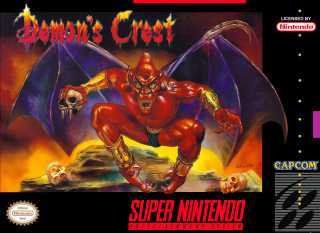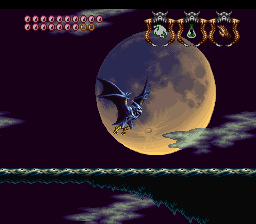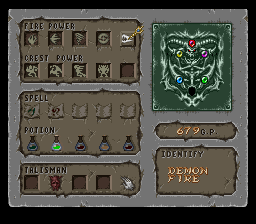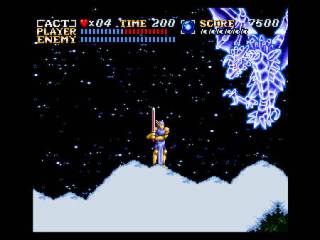The SNES Classic Mk. II: Episode I: Demons & Angels
By Mento 1 Comments
The SNES Classic had a sterling assortment of games from Nintendo's 16-bit star console, but it's hardly all that system has to offer a modern audience. In each installment of this fortnightly feature, I judge two games for their suitability for a Classic successor based on four criteria, with the ultimate goal of assembling another collection of 25 SNES games that not only shine as brightly as those in the first SNES Classic, but have equally stood the test of time. The rules, list of games considered so far, and links to previous episodes can all be found at The SNES Classic Mk II Intro and Contents.
Episode I: Demons & Angels
The Candidate: Capcom's Demon's Crest.

My only memories of Demon's Crest prior to this week were renting it and being completely flummoxed by its lack of direction. It has a memorable start: Firebrand, our demonic anti-hero, is dropped in an arena and forced to fight an enormous zombified dragon. The fight itself isn't too difficult, but there's very few games that start with a climactic boss fight with zero build-up or plot. After that, you're required to complete the rest of the level - again, no tutorials for what Firebrand can do, though the player should catch up pretty quickly just by testing the face buttons - and then are given a world map to explore with four levels to visit and a handful of unmarked locations.
What plot details you get are sparing: Firebrand found a bunch of superpowered crests one day that gave him ultimate power, but he was betrayed by another demon, Phalanx, and sealed away. After reawakening years later, Firebrand has found that the Demon Realm is the thrall of Phalanx who has used the crests to install himself as ruler, and the aggrieved fire demon sets out to take back what is rightfully his.
I figure this backstory refers to a previous game in this series: Demon's Crest is actually the third game in the Gargoyle's Quest sub-series, a spin-off of Capcom's macabre Ghouls N' Ghosts. The first two Gargoyle's Quest games were released for the original Game Boy, and were called Red Arremer: Makaimura Gaiden in Japan, or "Firebrand: Ghouls N' Ghosts Gaiden"; I'd assume the renaming and greenify-ing of Firebrand overseas was done to provide some distance from the whole "demonic" angle that parents and moral crusaders were keeping an eye out for, though they appear to have dropped the Bowdlerized facade for Demon's Crest. Red Arremer/Firebrand was originally a notorious minor villain in the original games, since he had this unpredictable swooping attack pattern that made it difficult to avoid him, and the subsequent love/hate attitude he received from players made him popular enough to prompt his own spin-off series.

In Demon's Crest, as in Gargoyle's Quest, the game is structured in a semi-spacewhipper like fashion. Firebrand can find various upgrades through exploration, from permanent HP boosts to new forms that confer additional abilities. Each stage has a few bosses and alternate paths, and the player is free to leave the stage whenever they reach the end of a path or get a game over, and try somewhere else. Even in his default form before finding any power-ups, however, Firebrand has a few abilities that make traversal more palatable: he is capable of a form of flight which essentially amounts to hovering on the same horizontal plane, albeit indefinitely, as well as a standard fireball projectile and a headbutt that allows him to break background objects. Different forms provide new projectiles as well as new abilities that replace Firebrand's headbutt: the Earth elemental Ground Gargoyle form, for instance, switches the fireball with a power geyser-like move that travels along the floor, while the headbutt is now a charging tackle that can destroy obstacles. However, there are often caveats: the Ground Gargoyle lacks the ability to fly, for instance, and his projectile is far weaker when fired from mid-air. The projectiles of the various forms follow a sort of Mega Man system, where certain types seem to work better against specific bosses, though the flipside is that they sometimes have no effect at all.
True to its spacewhipper roots, you'll often acquire a new form and then be encouraged to revisit previous levels to unlock new paths and items with the new abilities that form provides. Revisiting stages with bodies of water with the Tidal Gargoyle form, for instance, opens up underwater passages that would've killed you to reach otherwise (water and fire demons don't mix, turns out). It's not always clear where these items and paths are hiding - there's no incidation on the world map or elsewhere that a region still has secrets to find - but the game is comparatively short even compared to something like Super Metroid. The whole game is about fifteen to twenty areas across seven zones - the fifth and sixth open up the more forms you collect, and the seventh only becomes available when the game determines you're ready for the final boss - and it wouldn't take that long to backtrack to them all if you're hunting for the last item on your checklist. Unfortunately, you do need to find everything to unlock the true final boss, but I sort of like that there were spacewhippers around back then that put so much value into 100% item acquisition.

The star of the show here is the flexibility of the hero, both in terms of how well his hover and wall-grabbing come together when traversing the trap-filled levels, but how his multiple forms greatly expand his exploration opportunities. It's neat to come back to some early level and discover a new passageway, which uncovers a completely different zone with its own visual design, unique enemies and a tough boss at the end. With all that in mind, it's time to put it through the rigors of the P.O.G.S. system:
Preservation: Demon's Crest has held up very well indeed. Between its structure and sharp and expressive pixel graphics, it's a game that could easily exist today as an Indie spacewhipper. There are surprisingly few irritations common to archaic game design of the nineties: in fact, the game lets you continue as many times as you want, as well as providing the option to escape to the world map if you need to stock up on consumables or hunt for more power-ups elsewhere to be better prepared for the dangers ahead. It still has a password system and won't replenish any consumables used up between retries, which is a little vexing, but it's a remarkably affable game given the abjectly cruel "Nintendo Hard" legacy of its parent franchise. 4.
Originality: The game was released six months after Super Metroid and it shows in a lot of ways, but at the same time it's also the third entry in a series that was already doing the spacewhipper thing to some extent. That, of course, leads to another originality issue: how novel can a game be if it's the third game in a spin-off series? Taken in the abstract, Demon's Crest is a fairly distinct experience for SNES owners, given its structure of revisiting stages for new pathways and the fact that spacewhippers as a genre hadn't really taken off yet beyond Super Metroid and a few edge cases. 4.
Gameplay: A few difficulty spikes aside, Demon's Crest controls phenomenally well, and each of the game's zones contains their own distinct mixture of obstacles, enemies and level design. Aerial sections where you have to glide between enemies, or a slightly-maze like forest that becomes all the more dangerous once a flaming demon sets it ablaze. There's sections where the lights go out, causing annoying bat-like enemies to awaken and come after you, and you need to relight candles to deter them. It's a game full of surprises that doesn't outstay its welcome, and the versatility of Firebrand's abilities makes him one of the better action stars for the console. 4.
Style: Demon's Crest goes all-in on the macabre trappings of its forebears, creating some particularly grisly looking foes and backdrops. It also has its moments of beauty too, like a castle made entirely out of ice that the player visits during a clear night with a sparkling starry sky. It's one of the better looking games for the system in general, and even its Mode 7 overworld is presentable enough. I particularly like the level of detail that went into Firebrand and his various forms, each one perfectly modified for its particular strengths - fin-like flaps on the arms of the Tidal Gargoyle, for instance, or the gold trimmings on the wings of the late-game Legendary Gargoyle form. 5.
Total: 17.
The Nominee: Quintet/Enix's ActRaiser.

Enix came out of the gate swinging with ActRaiser, the fourth video game to be released on the Super Famicom (along with a port of Populous, which seems like a weird thematic coincidence). It was also the first game developed by Quintet, a new RPG studio set up by some former Nihon Falcom developers who dedicated themselves to producing some of the most distinctive games for the SNES system. We'll be visiting almost all of them in this series: I consider it a major ignominy that no Quintet game made it to the original SNES Classic, though given the current nebulous state of the studio there might be some licensing issues. ActRaiser, so far, is the only game of theirs to have made it onto the Virtual Console at least.
While it probably requires no introduction given its reputation and history with a certain long-suffering staff member on this site, let's do the thing anyway: ActRaiser is a combination god-sim and platformer, in which the player takes an active role in repelling demons from the lands inhabited by humans before chasing them into their lairs and annihilating them entirely. The game's structure is set up in such a way that the player first clears some space with an action stage, helps a human civilization to prosper while fighting off the waves of demons that come to cause chaos, and then completing a second action stage to wipe all remaining traces of demonic activity from the continent. While the action stages are compelling enough between the imaginative bosses and the tricky level design, it's the god-sim element that shines most: with the help of a cherubic assistant, the player has to clear out land to make it inhabitable for humans, direct the humans' growth to these areas, collect their tithes and answer their prayers, and destroy enemies and their spawners wherever they pop up. Each new territory brings with it new challenges, and it's tempting to maximize the amount of living space for your little mortal worshippers before moving onto what will no doubt be a gruelling boss encounter with the local area's demonic overlord.

The game was one of the first I can remember playing to combine "active" and "passive" (if only comparatively) gameplay modes as a way of creating a sort of gameplay "tide" that ebbs and flows to create something compelling in its malleability. You know that there's going to be a chill civilization-building section right after the tense platformer stage you're in, and likewise you can look forward to dropping into some hack and slash action if the current pattern of clearing land for settlers becomes dull. It's a pattern that has worked wonders for many of my favorite games to appear in the years since, such as Stardew Valley, Dark Cloud and the Persona games - the variation not only in the goals you're expected to accomplish, but the pace and immediacy with which the game moves. ActRaiser's definitely one of my all-time faves for the SNES, but how does the science pan out?
Preservation: ActRaiser's fairly timeless, and while there have been plenty of games that have done its individual aspects better - the platforming and the god-sim management - I'm struggling to think of any other game that has combined them, including ActRaiser's own sequel. It might be a little simple compared to modern games, but its unique structure is still as compelling as ever. 4.
Originality: Well, as previously stated, I don't think there are many games out there doing what ActRaiser did. We have seen a small burgeoning of RPGs with town-building systems, such as a few of the games mentioned above or the likes of Terraria and Dragon Quest Builders, but none of those employ 2D platformer stages as a frenetic counter-balance to a comparatively serene god-sim mode. Originality may well be ActRaiser's greatest strength to this day; unless I'm completely ignorant I don't think anyone's ever tried to bite its style just yet. 5.
Gameplay: ActRaiser both benefits and suffers from being two games in one, each a fairly solid example of its genre but due to the split focus of the game neither really stand out too much either. But that simplicity also helps: a full-bodied god-sim might not work so well on a console, especially one that had yet to introduce a mouse peripheral, and if the platforming was any more demanding it would probably be a roadblock to the less able player who had come to the game for the more casual god-sim aspect (though that person would still be completely screwed on the punishing final boss rush). Between the bosses and the new abilities earned on each new continent, there's enough variation to keep anyone's interest. 4.
Style: Graphically, ActRaiser is a little hit and miss. It's one of the first third-party games developed for the system, so in some ways it could be considered a trial run for what could be done with 16-bit graphics: something Enix and their erstwhile rivals Square quickly capitalized on. While the graphics are relatively plain throughout, there are a few touches of graphical genius, like the imposing crystal dragon boss and the seamless Mode 7 as you spiral your way down into a dungeon from the previously static overworld. 3.
Result: 16.
